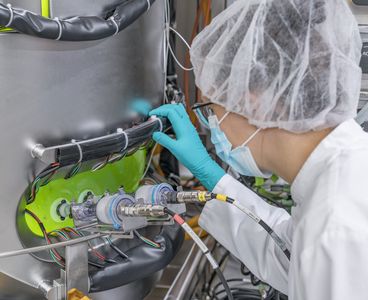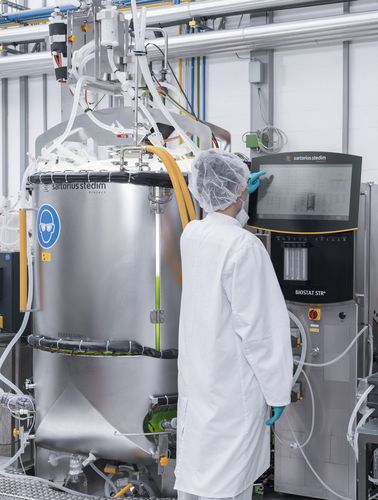
Case Studies
Extracts
Fibrinolytic Enzyme from snake venom for parenteral use
Until 2019 a fibrinolytic enzyme (Ancrod) was isolated from the snake venom of the malayan pit viper (Calloselasma rhodostoma). The purified drug substance was formulated into a drug product for intravenous and subcutanous application. Fibrinolytic enzymes lower the blood level of fibrinogen and thus lead to a reduction in blood viscosity. This mechanism has relevance in many indications.
Regardless the many challenges of this highly active and structurally complex substance, we were able to establish robust processes of purification, production and filling. The resulting product was applied in several clinical studies (drug product until phase II, drug substance until phase III).
Microbial fermentation
Oral lipase from fermentation
In this development project a bacterial lipase (INN Burlulipase) derived from bacterial fermentation was purified under GMP conditions.
The purified enzyme was tested successfully as an oral dosage form in several clinical studies with patients suffering from reduced or missing digestive pancreatic function (Pancreatic Exocrine Insufficiency). Compared to classical Pancreatin products Burlulipase has the following advantages:
- Gastric stability
- Very high specific activity
- Liquid formulation
These charcateristics mean tremendous advantages for the patient regarding application and handing. Throughout the whole development process, Nordmark benefits from it´s longstanding experiences with medicinal products for the treatment of exocrine pancreatic dysfunction.
Collagenase in high purity
Nordmark has developed a process that provides the active ingredient collagenase in high yields, high purity and a stable formulation. The process is based on fermentation by an in-house strain of the anaerobic bacterium Clostridium histolyticum. The specially developed fermentation medium is free of animal components and thus guarantees a high biological safety of the active ingredient.
Live Biotherapeutics (Microbiome)
Live Biotherapeutic Products are the next generation medicinal products e.g. for the treatment of chronic inflammatory bowel diseases in which missing „good bacteria“ are replaced. These highly complex dosage forms comprise a variety of bacterial strains in defined amounts. It is a demanding task to guarantee viability of the bacteria throughout production process and shelf life, but also during passage through the stomach. This is especially true as many bacteria are sensitive towards atmospheric oxygen.
In case of Live Biotherapeutic Products enabling consistent product quality also means to make sure that cells don´t mutate from batch to batch. Hence, it is necessary to establish different kinds of cell banks. From these cell banks, cells can then be cultivated, purified and transformed into a stable dosage form.
GMP compliant implementation of master and working cell banks is an established process at Nordmark. For the subsequent aerobic or anaerobic cell cultivation, we have fermenters of different scales at our disposition. Concerning the purification of the cell material, we can as well show longstanding experience. A pragmatic approach to a stable dosage form is then freeze drying of the cell material, milling of the lyophilisation cake and filling the powder into capsules. In this field Nordmark has also large know-how. We have realised the processing, standardisation, gastric resistant encapsulation and primary packaging of a bacterial product that was tested in a clinical study phase I.
Mammalian Cell Culture
Project example Bibitec: On the green path of moss - BIBITEC produces for eleva GmbH
Project example affiliate BIBITEC: On the green path of moss - BIBITEC produces for eleva GmbH

At BIBITEC´s main concern in the years 2019 and 2020 was the green moss. On behalf of eleva GmbH (formerly Greenovation Biotech GmbH, Freiburg) a total of six 500 L processes were carried out for two different products. All processes were based on Eleva's platform technology for the cultivation of the spreading earth moss (lat. Physcomitrella patens) in illuminated production reactors.
After BIBITEC had already produced three GMP batches of alpha-galactosidase drug substance at 300 L scale for clinical phase I in 2016, a 500 L STR bioreactor (Sartorius, Germany) specially developed and illuminated for Eleva for the cultivation of moss cells was set up at BIBITEC´s facility in late 2019.
The technical commissioning by our USP team was based on a 500 L MOCK cultivation for the generation of host cell proteins (HCP). Concentrated by ultrafiltration, the culture supernatant was used to develop a moss-specific HCP ELISA.
In the same period, our experts have been working on the production of a Master Cell Bank (MCB) and Working Cell Bank (WCB) for the alpha-galactosidase expressing production strain. The GMP-compliant production of cell banks was a novelty for BIBITEC but is an appreciated extension of our services.

At the beginning of 2020 the complete alpha-galactosidase production process was transferred from Eleva to BIBITEC. Beside an adapted cultivation strategy this included the establishment of different analytical methods. In addition, an upscaling of the purification process from 300 L to 500 L was achieved by our DSP team within a short time. A specification-compliant production batch demonstrated the successful technology transfer. Therefore, a 500 L production process for the GMP-compliant production of alpha-galactosidase was established and is now available at BIBITEC for further clinical studies.
In mid 2020, BIBITEC started the development of the Factor H production process, a new pioneer project of Eleva. A total of four successful 500 L batches were performed to develop the cultivation process. In regular exchange with Eleva, BIBITEC has succeeded in establishing a potent process which clearly exceeded the expectations of the produced Factor H quantity. Part of process development was the testing and adaptation of different process and feeding strategies as well as the establishment of a suitable cell separation and concentration of the culture supernatant by ultrafiltration.
